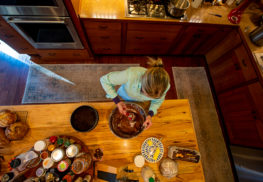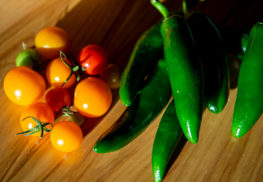German Rabbit Stew

Chef Hank Shaw
Author of Hunter, Gather, Cook: Finding the Forgotten Feast & Duck, Duck, Goose: Recipes and Techniques for Cooking Ducks and Geese
Ingredients
2 cottontail rabbits, or 1 domestic rabbit, cut into serving-size pieces
Salt
2 tablespoons unsalted butter
2 tablespoons flour
1 to 2 cups chicken stock
1 onion, sliced root to tip
Zest of a lemon, cut into wide strips (and white pith removed)
2 to 3 bay leaves
¼ cup lemon juice
½ cup sour cream
2 tablespoons capers
White wine to taste, at least 2 tablespoons
Black pepper
Parsley for garnish
Directions
1 Salt the rabbit pieces well and set aside for 10 minutes or so. Set a Dutch oven or other heavy, lidded pot over medium-high heat. Melt in 1 tablespoon of unsalted butter, pat the rabbit pieces dry, and brown well on all sides.You may need to do this in batches, so don’t crowd the pot and don’t rush things. Remove the rabbit pieces once they’re browned. This may take 15 minutes or so.
2 Add the remaining tablespoon of butter and then the sliced onion, and cook until the edges just begin to brown, about 6 minutes. Sprinkle with flour and stir well. Cook, stirring often, until the flour turns golden, about 5 minutes.
3 Return the rabbit to the pot and add enough chicken stock to cover. Use a wooden spoon to scrape any browned bits off the bottom of the
4 pot. Add the lemon zest, bay leaves, and lemon juice; bring to a simmer. Cover and cook gently until the rabbit wants to fall off the bone, which will take anywhere from 90 minutes to 3 hours, depending on how old (tough) your rabbit was.
5 This is an optional step, but preferred: Turn off the heat, fish out the rabbit pieces, and let them cool on a baking sheet. Pull all the meat off the bones and return the meat to the stew.
6 Serve this with bread or potatoes and a crisp, German white wine. A lager beer would be good, too. Serves 4 to 6.
Serves 4 to 6.
Hank’s Tips
1 Butchering a rabbit is harder than cutting up a chicken. If you are butchering the rabbit yourself, visit the site www.honest-food.net for a tutorial titled How to Cut Up a Rabbit.
2 Flavorwise, this stew really works well with lighter meats. Don’t use hare or jackrabbit for this recipe—stick to cottontails, domestic rabbits, or snowshoe hares, which are all white-meat rabbits. Chicken thighs would work well here, too, as would pheasant. It is a two-step stew, meaning you make the base and “mount” it with sour cream, white wine, and capers right at the end. Once you add those final ingredients you are committed, so if you want to make this for dinners or lunches for the week, store just the base (up to Step 4) and add the remaining ingredients when you want to eat.
SHARE ON
You may also like
Recipe and commentary by Rachel Hogan...
Recipe and commentary by Joanne Linehan...
Recipe and commentary by Joanne Linehan...



























